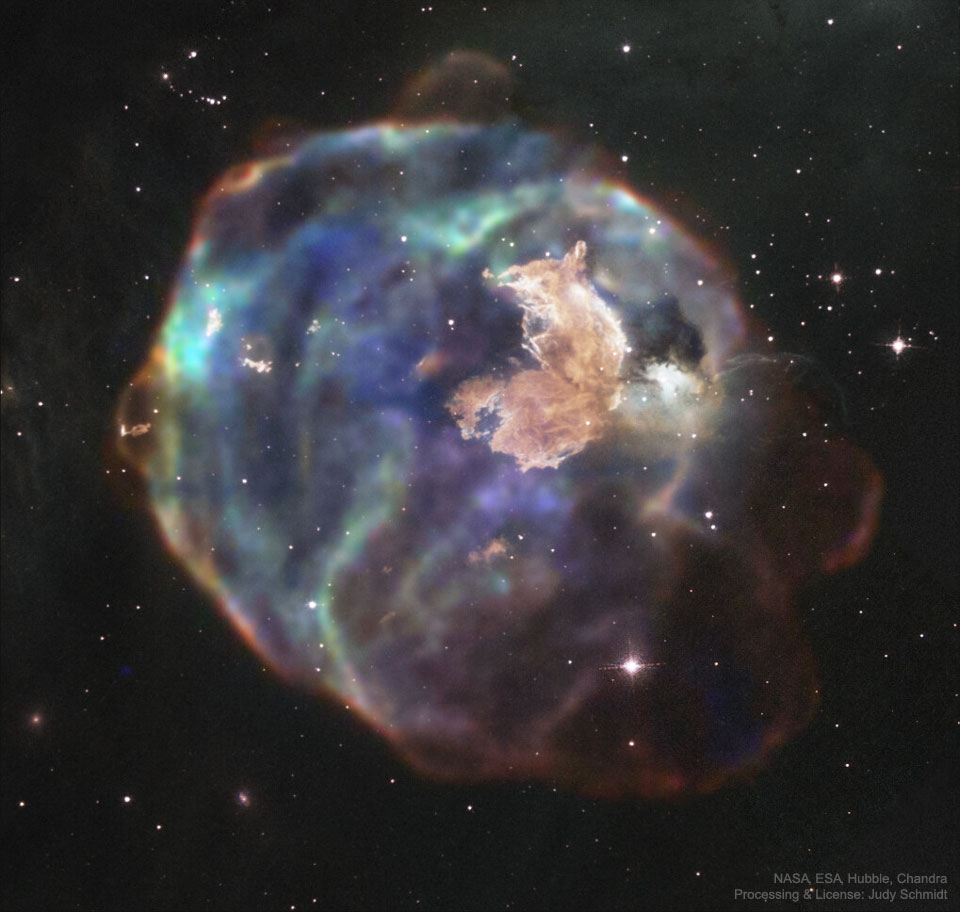2019 December 11
N63A: Supernova Remnant in Visible and X-ray
Image Credit: NASA, ESA, Hubble, Chandra; Processing & License: Judy Schmidt
Explanation: What has this supernova left behind? As little as 2,000 years ago, light from a massive stellar explosion in the Large Magellanic Cloud (LMC) first reached planet Earth. The LMC is a close galactic neighbor of our Milky Way Galaxy and the rampaging explosion front is now seen moving out – destroying or displacing ambient gas clouds while leaving behind relatively dense knots of gas and dust. What remains is one of the largest supernova remnants in the LMC: N63A. Many of the surviving dense knots have been themselves compressed and may further contract to form new stars. Some of the resulting stars may then explode in a supernova, continuing the cycle. Featured here is a combined image of N63A in the X-ray from the Chandra Space Telescope and in visible light by Hubble. The prominent knot of gas and dust on the upper right — informally dubbed the Firefox — is very bright in visible light, while the larger supernova remnant shines most brightly in X-rays. N63A spans over 25 light years and lies about 150,000 light years away toward the southern constellation of Dorado.
N63A:超新星遗迹的可见光和X射线影像
影像提供: NASA, ESA, Hubble, Chandra; 影像处理与授权: Judy Schmidt
说明: 这颗超新星留下了什么?可能不到2,000年前,在邻近银河系的大麦哲伦星系 (LMC)里,一颗大质量恒星发生爆炸,其初始的亮闪曾传到地球。而所产生的狂暴激波前缘,目前仍持续向外扩张,摧毁或推开周围的云气,留下许多相对致密的云气和尘埃纠结。并在大麦哲伦星系内,留下了一个庞大的超新星遗迹:N63A。这些受到压缩的致密纠结,可能会进一步塌缩形成新恒星。其中有些新恒星,将来可能也会发生超新星爆炸,延续恒星的生死轮回。上面这幅N63A主题影像,组合了钱德拉太空望远镜的X射线照片,以及哈伯太空望远镜可见光照片。其中在影像右上角,极为醒目、昵称为火狐的气体和尘埃结,在可见光波段非常明亮,而范围较大的超新星遗迹,则是在X射线波段最明亮的结构。离我们约150,000光年远,大小超过25光年的N63A,位在南天的剑鱼座内。



